 1956 DeSoto Firedome Four-Door Seville Dimensions, Size & Specs
1956 DeSoto Firedome Four-Door Seville Dimensions, Size & Specs
Measurements of the 1956 DeSoto Firedome Four-Door Seville, engineered for optimal performance and comfort
| Dimensions | |
|---|---|
| Length: | 5535 mm217.9 in18.2 ft |
| Width: | 1989 mm78.3 in6.5 ft |
| Height: | 1539 mm60.6 in5.0 ft |
| Ground Clearance: | 160 mm6.3 in0.5 ft |
The 1956 DeSoto Firedome Four-Door Seville represents a classic example of mid-1950s American sedan design and engineering. Produced between 1955 and 1956, this model features substantial dimensions that emphasize its large and commanding presence on the road. With a length of 5535 mm (approximately 218 inches), it offers spacious interior room and a distinctive elongated profile typical of the era. The width measures 1989 mm (around 78.3 inches), providing a wide stance that contributes to stability and cabin comfort. Standing at 1539 mm tall (about 60.6 inches), the Firedome sedan maintains a balanced height that complements its overall proportion. Ride height, or ground clearance, is 160 mm (6.3 inches), which contributes to a comfortable ride quality over varied road surfaces. The Firedome Four-Door Seville showcased the styling cues and robust build of DeSoto cars during the mid-50s, reflecting the automotive trends favoring sizeable sedans with powerful performance and spacious interiors. Its size classifies it as a large sedan by today's standards, capturing the essence of luxury and road presence characteristic of its generation. Enthusiasts and collectors appreciate the Firedome for its classic design and its role in DeSoto’s legacy during the American automotive golden age.
Discover the standout features that make the 1956 DeSoto Firedome Four-Door Seville a leader in its class
Have a question? Please check our knowledgebase first.
The 1956 DeSoto Firedome Four-Door Seville is a substantial sedan with an overall length of 5535 mm (217.9 inches), a width of 1989 mm (78.3 inches), and a height of 1539 mm (60.6 inches). These dimensions reflect the mid-1950s American car design trend, emphasizing spacious interiors and a commanding road presence. With its generous length and width, the Firedome provides ample cabin space for passengers, making it a comfortable vehicle for families or long journeys. The relatively moderate height contributes to good aerodynamics and a balanced profile. This size positions the Firedome Four-Door Seville as a full-size sedan of its era, combining luxury with a robust physical presence.
The 1956 DeSoto Firedome Four-Door Seville has a ride height or ground clearance of 160 mm (6.3 inches). This ground clearance was quite typical for sedans of the 1950s and ensures the vehicle can handle various road conditions commonly encountered during that period, from paved highways to less developed roads. A 160 mm clearance helps to avoid undercarriage damage from bumps while maintaining a relatively low center of gravity for better stability and handling. It strikes a balance between comfort and practicality, contributing to a smooth ride, which was an important factor for luxury-oriented sedans like the Firedome.
The 1956 DeSoto Firedome Four-Door Seville’s size of 5535 mm in length (approximately 18.2 feet) and 1989 mm in width (approximately 6.5 feet) makes it somewhat large by modern standards. Standard residential garages in the United States typically measure about 6 meters (20 feet) in length and 3 meters (10 feet) in width, which means the Firedome should physically fit in lengthwise with limited extra space and comfortably fits width-wise. However, maneuvering inside the garage might be tighter due to its width and the need for door clearance. Owners of the Firedome should check their garage dimensions carefully, especially the width, to ensure sufficient space for comfortable parking and ease of access.
The 1956 DeSoto Firedome Four-Door Seville was produced from 1955 to 1956, replacing earlier Firedome models from the early 1950s. Compared to its predecessor, this generation retained a similar full-size sedan footprint but introduced styling and possibly dimensional updates that emphasized a more modern, squared-off profile typical of mid-50s American cars. Generally, dimensions for length and width saw minor increases or remained stable to provide enhanced passenger comfort and trunk space, while maintaining the vehicle's overall luxury appeal. This generation reflected the transition toward larger and heavier cars with more robust styling, meaning the 1956 model was at least as spacious, if not slightly more so, than its predecessor.
At 1989 mm (78.3 inches) wide, the 1956 DeSoto Firedome Four-Door Seville is broader than many modern sedans, which typically range between 1800 mm (70.9 inches) and 1850 mm (72.8 inches) in width. This wider stance was common in mid-20th-century American full-size vehicles, providing an expansive cabin and a feeling of spaciousness. The extra width also contributed to stability and road presence. However, the broader width can make navigating through narrow urban streets or parking in tight modern spaces more challenging. In comparison, modern sedans prioritize a balance between interior space and external dimensions for improved fuel efficiency and maneuverability.
Standing at 1539 mm (60.6 inches) tall, the 1956 DeSoto Firedome Four-Door Seville exhibits a relatively moderate height for a full-size sedan of its era. This height provides ample headroom inside the cabin, enhancing passenger comfort for both front and rear occupants. Moreover, the moderate height contributes to a balanced aerodynamic profile with a lower drag coefficient compared to taller vehicles like SUVs or trucks of today. Despite the era's limited aerodynamic focus compared to modern cars, the Firedome's height helped maintain stability at cruising speeds while providing the commanding presence expected from a luxury sedan of the 1950s.
While specific official curb weight figures for the 1956 DeSoto Firedome Four-Door Seville are not widely documented, typical full-size sedans of this era generally weighed between 1700 kg to 1900 kg (approximately 3748 to 4189 lbs). This substantial weight, combined with a powerful V8 engine typical of Fiona DeSoto models, contributed to a smooth and stable ride but affected acceleration and fuel economy in a way typical for cars of the 1950s. The heavyweight construction aided in ride comfort and safety but demanded robust braking systems and suspension tuning to handle the mass effectively. Vehicle weight plays a large role in overall performance, including handling, braking distance, and fuel consumption.
In the mid-1950s, the DeSoto Firedome Four-Door Seville competed in the full-size luxury sedan segment alongside brands like Chevrolet Bel Air, Buick Special, and Chrysler Windsor. At 5535 mm (217.9 inches) long and 1989 mm (78.3 inches) wide, the Firedome was among the larger sedans, with a luxurious interior and stylish design cues typical of its class. DeSoto positioned the Firedome to balance performance, comfort, and style, offering a fluid ride and spacious seating arrangement. Compared to competitors, the Firedome’s size helped emphasize its premium status, with broad dimensions providing generous passenger space and trunk capacity compared to many contemporaries which were slightly smaller or less extravagantly appointed.
The 1956 DeSoto Firedome Four-Door Seville inherited many advanced features for its time, including the powerful V8 HEMI engine that was known for high performance and smooth operation. The model had stylish exterior design updates featuring tail fins, a hallmark of 1950s car styling, and a spacious, comfortable interior trimmed with quality materials. Its suspension setup provided enhanced ride comfort suited for luxury driving, while the size gave a roomy cabin and large trunk capacity. This generation also benefited from mechanical refinements aimed at improving reliability and ease of driving, reflecting DeSoto’s premium positioning in the Chrysler corporate family at the time.
With a length of 5535 mm (217.9 inches) and width of 1989 mm (78.3 inches), the 1956 DeSoto Firedome Four-Door Seville is relatively large for urban environments. Maneuvering and parking in tight city spaces can be challenging due to its broad width and length, which are larger than many contemporary cars. Drivers often needed to be very attentive in narrow streets or congested areas. However, the vehicle’s steering effort and low-speed handling dynamics could somewhat compensate for its size, and the roomy cabin and ride comfort often offset urban driving inconveniences. Overall, while manageable, urban navigation required patience and skill.
Discover similar sized cars.
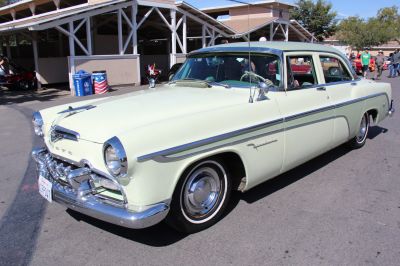
| Production: | 1954-1955 |
|---|---|
| Model Year: | 1955 |
| Length: | 5535 mm217.9 in |
| Width: | 1989 mm78.3 in |
| Height: | 1539 mm60.6 in |
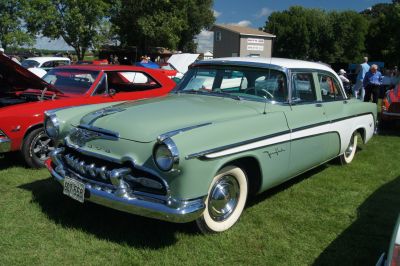
| Production: | 1954-1955 |
|---|---|
| Model Year: | 1955 |
| Length: | 5535 mm217.9 in |
| Width: | 1989 mm78.3 in |
| Height: | 1539 mm60.6 in |
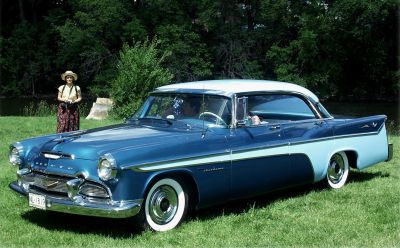
| Production: | 1955-1956 |
|---|---|
| Model Year: | 1956 |
| Length: | 5535 mm217.9 in |
| Width: | 1989 mm78.3 in |
| Height: | 1539 mm60.6 in |
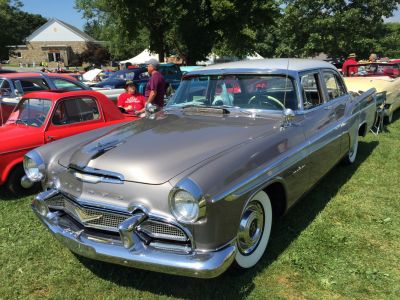
| Production: | 1955-1956 |
|---|---|
| Model Year: | 1956 |
| Length: | 5535 mm217.9 in |
| Width: | 1989 mm78.3 in |
| Height: | 1539 mm60.6 in |
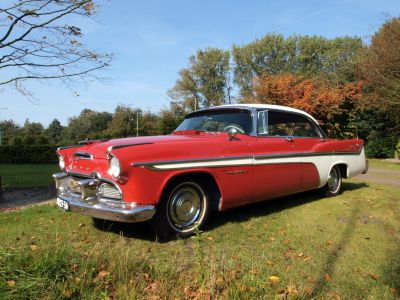
| Production: | 1955-1956 |
|---|---|
| Model Year: | 1956 |
| Length: | 5535 mm217.9 in |
| Width: | 1989 mm78.3 in |
| Height: | 1539 mm60.6 in |
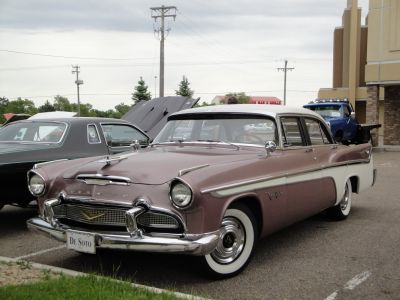
| Production: | 1955-1956 |
|---|---|
| Model Year: | 1956 |
| Length: | 5535 mm217.9 in |
| Width: | 1989 mm78.3 in |
| Height: | 1539 mm60.6 in |
